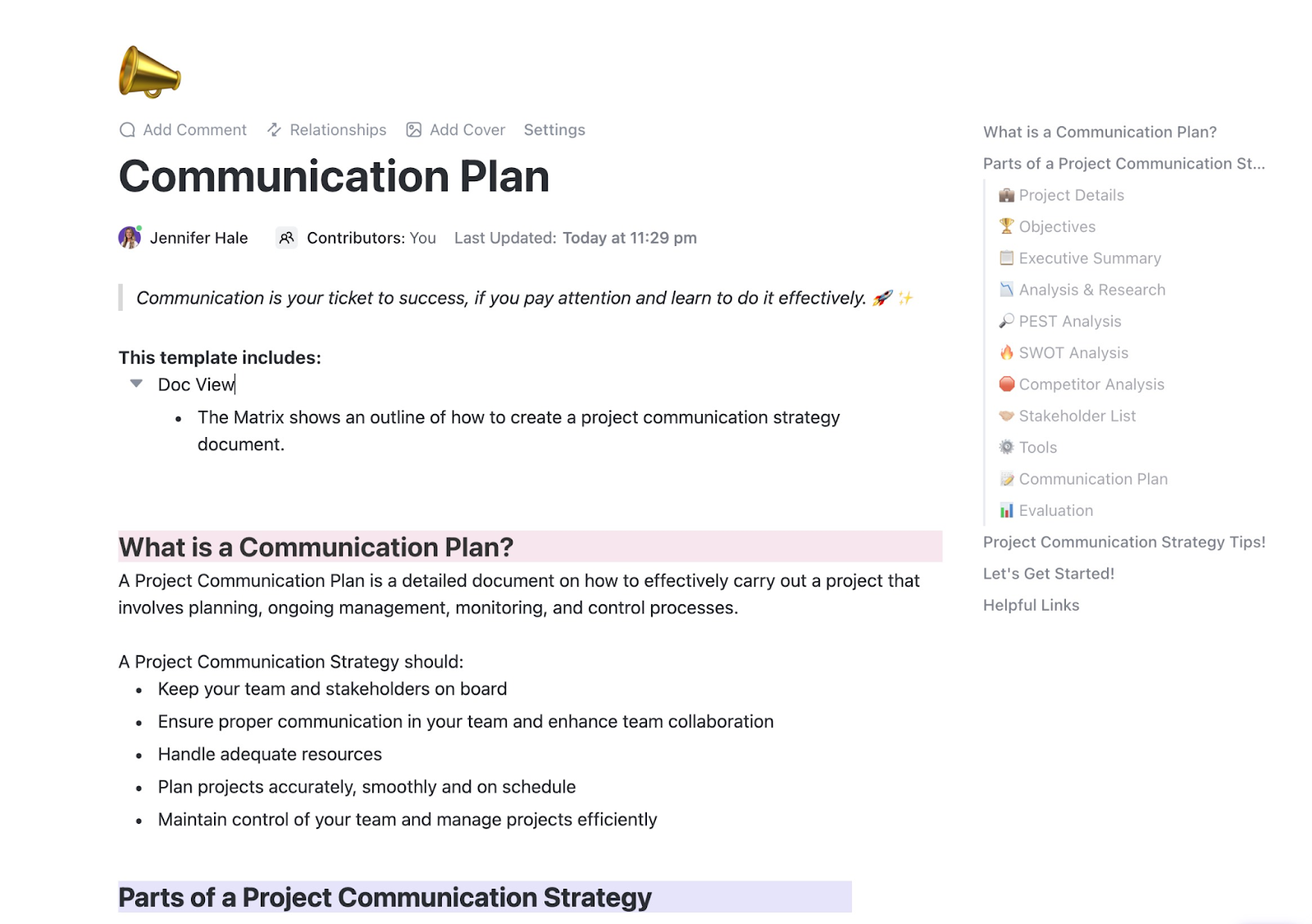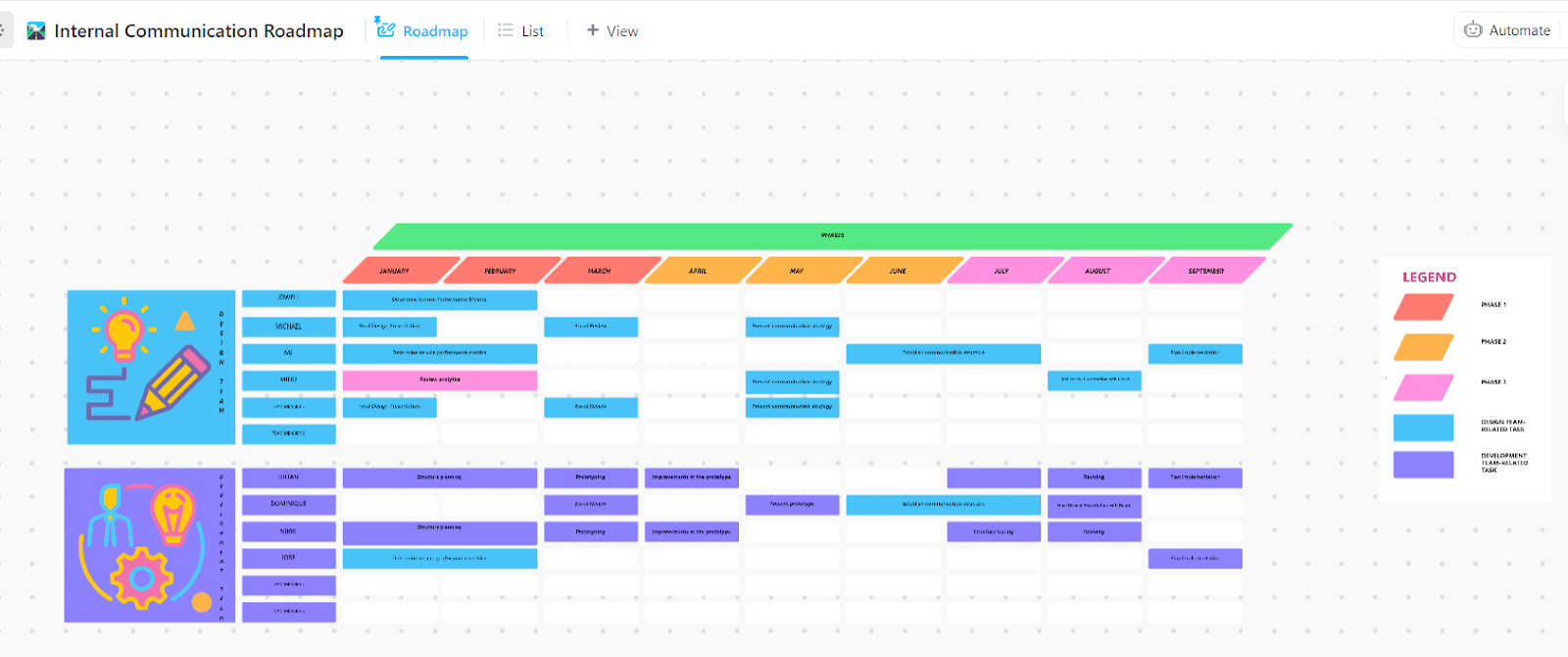ما يقرب من 60٪ من الموظفين يردون على الرسائل الفورية في غضون 10 دقائق. في حين أن هذه الردود السريعة والتواصل في الوقت الفعلي غالبًا ما يُعتبران من علامات الكفاءة، إلا أنهما يشتتان التركيز ويعيقان العمل المكثف.
إذا أردنا تحقيق إنتاجية حقيقية للفريق، فإن التواصل يحتاج إلى إعادة ضبط.
تغير الاتصالات غير المتزامنة التعاون نحو الأفضل. إنها بديل منتج لإدارة الفرق، وتقليل الساعات الضائعة، والحفاظ على التوازن بين العمل والحياة.
ستكشف هذه المدونة ما هو، ولماذا يعمل، وكيف يمكن أن يفيدك. وإذا بقيت معنا، فسوف نشاركك أيضًا معلومات داخلية حول كيف أن ClickUp هو الأداة الوحيدة التي تحتاجها لتبني التواصل غير المتزامن بسلاسة!
ما هي الاتصالات غير المتزامنة؟
التواصل غير المتزامن هو نوع من التواصل حيث يتبادل الأشخاص المعلومات دون توقع رد فوري. بدلاً من المشاركة في الوقت الفعلي أو وجهاً لوجه، مثل الاجتماعات أو المكالمات، تجري المحادثات على مدار الوقت من خلال أدوات مثل البريد الإلكتروني أو تطبيقات المراسلة أو مقاطع الفيديو المسجلة.
يمكن للجميع الرد عندما يكون ذلك مناسبًا لهم — لا داعي للتواجد على الإنترنت في نفس الوقت.
👀 هل تعلم؟ 51٪ من الموظفين يعانون من الإجهاد بسبب سوء التواصل. يمكن للتواصل غير المتزامن أن يقلل بشكل كبير من الإجهاد في مكان العمل — خاصة في الفرق الرقمية أو التي تعمل عن بُعد — من خلال منح الأشخاص مزيدًا من التحكم والوضوح والمساحة لتفاعلاتهم.
لماذا تعتبر الاتصالات غير المتزامنة مهمة؟
يمنح التواصل غير المتزامن الفرق مساحة للتركيز والتفكير بوضوح وتجنب الإرهاق. بدون الضغط للرد على الفور، يمكن للأشخاص الانخراط في العمل بعمق وتجنب المقاطعات المستمرة.
وهو مفيد بشكل خاص للفرق العالمية أو البعيدة التي تتعامل مع مناطق زمنية مختلفة. بالإضافة إلى ذلك، فإنه يحسن جودة المحادثات بشكل طبيعي: حيث يأخذ الناس الوقت الكافي للتفكير والرد بشكل مدروس.
كما أن الأدوات غير المتزامنة تترك أثراً مكتوباً أو مسجلاً، مما يسهل الرجوع إلى القرارات وتجنب سوء الفهم. باختصار، إنها توفر مزيداً من المرونة، وتركيزاً أفضل، وتواصل فعال.
📮ClickUp Insight: تُظهر بيانات استطلاع فعالية الاجتماعات لدينا أن 25٪ من الاجتماعات تضم 8 مشاركين أو أكثر في المتوسط. وجدنا أيضًا أن متوسط مدة الاجتماع يبلغ حوالي 51 دقيقة. يمكن أن تؤدي هذه الاجتماعات الكبيرة إلى قضاء ما لا يقل عن 6 إلى 8 ساعات من وقت الاجتماعات الجماعية أسبوعيًا على مستوى المؤسسة.
ماذا لو كان بإمكانك تقليصها؟ ClickUp يغير طريقة تواصل الفرق! بدلاً من الاجتماعات المطولة، تعاون مباشرةً في المهام باستخدام التعليقات والمرفقات والملاحظات الصوتية ومقاطع الفيديو والمزيد — في مكان واحد.
💫 نتائج حقيقية: لقد وفرت فرق STANLEY Security العالمية بالفعل أكثر من 8 ساعات أسبوعيًا في الاجتماعات والتحديثات باستخدام تطبيقنا الشامل للعمل!
كيف تعمل الاتصالات غير المتزامنة
تستند العقلية غير المتزامنة إلى فكرة بسيطة: شارك المعلومات الآن، ورد عندما يناسبك ذلك.
📌 من أمثلة التواصل غير المتزامن: قيام كاتب ومحرر بتحرير دراسة حالة معًا (ولكن ليس في الوقت الفعلي) على ClickUp Docs المشترك، وجمع السياق من سلاسل مناقشة المشروع على قناة ClickUp Chat، ونشر تحديثات التقدم كتعليقات على ClickUp Task، ومشاركة تسجيلات الشاشة لتعريف المنتج عبر ClickUp Clips.
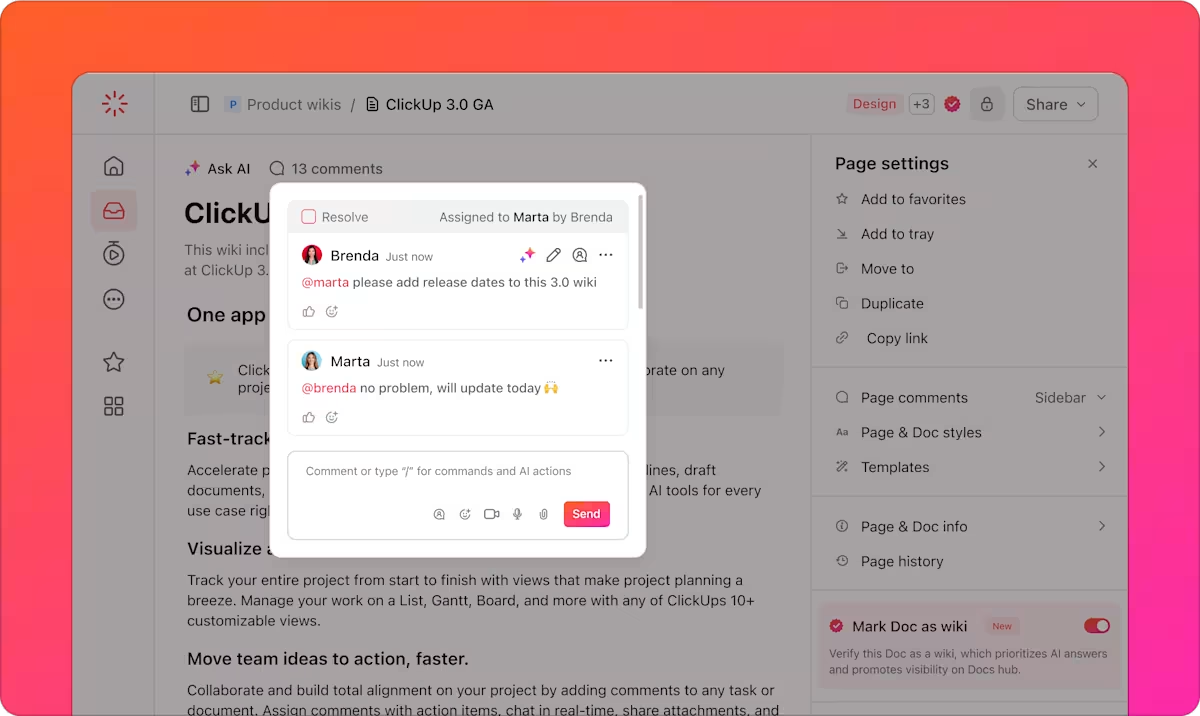
هذه ليست سوى بعض من الأدوات العديدة التي تحافظ على تنظيم تحديثاتك وإتاحتها متى احتجت إليها. (سنناقش كيفية استخدامها جميعًا 🔜 في منشور المدونة، لذا تابعنا!)
إليك ما يجعلها فعالة:
- يمكنك الوصول إلى المعلومات مثل التعليقات أو المستندات أو الرسائل المخزنة والمشتركة في قنوات الاتصال في أي وقت.
- أخر الردود دون الشعور بالذنب، مما يتيح لأعضاء الفريق حرية الرد بعد التفكير، وليس فقط السرعة.
- قم بتحقيق التقدم في العمل بشكل مستقل وبالسرعة التي تناسبك، دون الحاجة إلى حضور الجميع في نفس الوقت.
🧠 حقيقة ممتعة: لا يزال الحضور إلى المكتب أقل بنسبة 30٪ بعد الجائحة بسبب زيادة أنظمة العمل المختلطة.
كيفية تنفيذ التواصل غير المتزامن في مكان عملك
لا يمكنك تنفيذ أساليب التعاون غير المتزامن في مكان العمل الحديث بمجرد استضافة أو حضور عدد أقل من الاجتماعات. يجب عليك إعداد الأنظمة والعادات والتوقعات المناسبة من خلال التخطيط المسبق لبناء ثقافة الفريق وإنتاجيته دون التضحية بالوضوح.
إليك كيفية تنفيذ هذه العملية:
الخطوة 1: حدد المهام التي يجب أن تكون غير متزامنة
ابدأ بتقسيم سير العمل والرسائل التي يمكنك التعامل معها بشكل غير متزامن.
- تحديثات المهام؟ نعم
- هل تفكر في استجابة للأزمة؟ ربما لا
هذا التمييز يضمن أن الاتصال غير المتزامن لا يبطئ الأمور العاجلة.
إليك دليل مفيد لحالات الارتباك:
| نوع الاتصال | أفضل استخدام | أمثلة |
| ✅ غير متزامن | مهام واضحة وغير عاجلة | تخطيط المشاريع، ومقترحات الميزات، والتعاون متعدد الوظائف |
| 🔄 هجين | مواضيع معقدة بعض الشيء قد تحتاج إلى توضيح | تخطيط المشاريع، مقترحات الميزات، التعاون بين الوظائف المختلفة |
| 🗣️ متزامن | المسائل العاجلة أو العاطفية أو ذات المخاطر العالية | حل النزاعات، والاستجابة للأزمات، والعصف الذهني في الوقت الفعلي، والموافقات في المواعيد النهائية الضيقة. |
الخطوة 2: حدد مكانًا محددًا للعمل غير المتزامن
يمكن أن تصبح الاتصالات غير المتزامنة فوضوية بسرعة عندما تكون موزعة عبر البريد الإلكتروني وتطبيقات المراسلة الفورية ومحركات الأقراص المشتركة. اختر مساحة مركزية تربط المحادثات بالمهام والوثائق والتحديثات والملكية.
اقتراحنا: ClickUp!
ClickUp،التطبيق الشامل للعمل، هو مركز عملك غير المتزامن — المصمم للحفاظ على تماسك الفرق دون الحاجة إلى اجتماعات أو مراسلات مستمرة. فهو يجمع مهامك ووثائقك ومحادثاتك في منصة واحدة قوية مدعومة بالذكاء الاصطناعي حتى لا يضيع أي شيء في سلاسل الرسائل الإلكترونية أو رسائل Slack.
هل تحتاج إلى تحديث للمشروع؟ استخدم Team StandUp Autopilot Agent أو ClickUp Brain لتلخيص التقدم المحرز باستخدام الذكاء الاصطناعي، دون الحاجة إلى سؤال أعضاء فريقك. هل تريد تقديم ملاحظات؟ اترك تعليقًا على مستند وقم بتعيينه إلى عضو الفريق المعني.

من الأتمتة المدعومة بالذكاء الاصطناعي إلى الإشعارات في الوقت الفعلي وسير العمل القابل للتخصيص، يركز ClickUp المعرفة والتواصل بين أعضاء الفريق حتى يتقدم العمل، حتى عندما تكون غير متصل بالإنترنت. مع وجود كل شيء في مكان واحد، يحصل فريقك على الوضوح والمسؤولية والراحة التي يحتاجها لأداء أفضل عمل له - في الوقت الذي يناسبه.
تحدث مع السياق في ClickUp Chat والتعليقات
لا تكون الاتصالات غير المتزامنة فعالة إلا عندما يكون لدى الجميع الصورة الكاملة — وهذا بالضبط ما يقدمه ClickUp Chat. بدلاً من التوفيق بين سلاسل المحادثات في Slack والرسائل المتفرقة، يمكن لفريقك إجراء محادثات مركزة مباشرةً ضمن قوائم المهام ومساحات المشاريع للحفاظ على السياق.
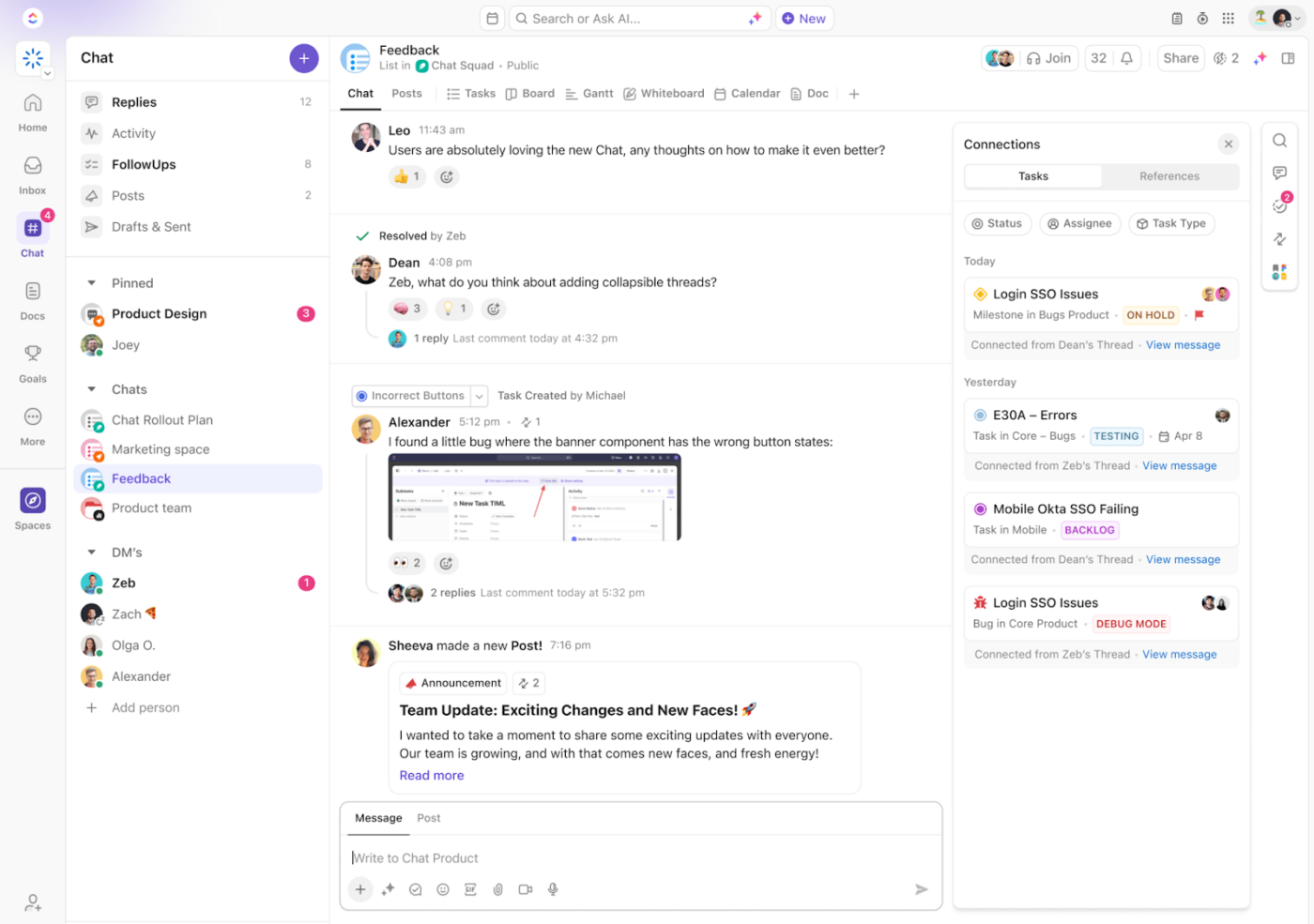
يمكن لفريقك الرد وإدراج روابط للمهام ذات الصلة أو حتى تحويل رسالة الدردشة إلى مهمة يجب القيام بها إذا لزم الأمر. تظل المحادثات مرتبطة بالعمل، في المكان الذي تنتمي إليه بالضبط.
يمكنك أيضًا استخدام @mentions في تعليقات ClickUp لجذب انتباه شخص ما إلى مهمة أو مستند معين.
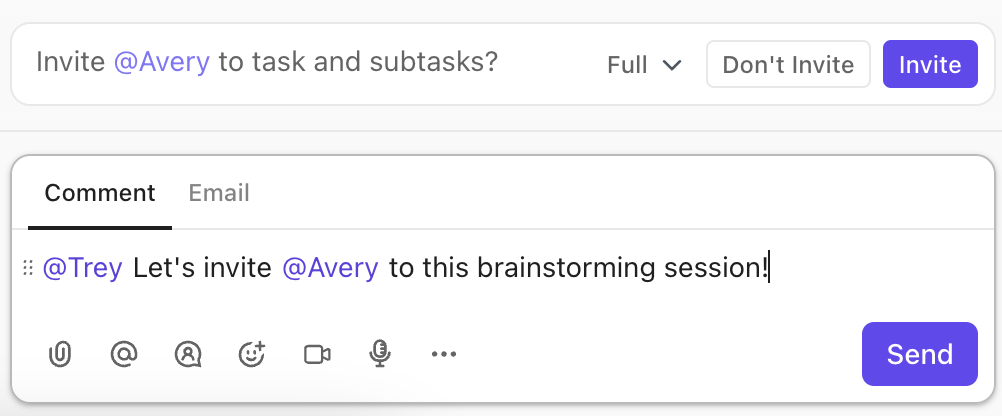
وإليك كيفية ذلك:
- اكتب "@" لتمييز شخص أو فريق: في أوصاف المهام والتعليقات والمستندات وحتى الدردشة، تجذب الإشارة @ البسيطة الانتباه.
- إضافة المراقبين تلقائيًا: إن ذكر شخص ما في تعليق على مهمة يجعله على الفور مراقبًا ويبقيه على اطلاع دائم.
- إشعارات التشغيل: يتلقى الأشخاص الذين تمت الإشارة إليهم بعلامة @ إشعارات فورية، مما يعزز المساءلة.
أتمتة التحديثات غير المتزامنة باستخدام ClickUp Brain و Autopilot Agents
يتميز نظام ClickUp بقدرات فائقة بفضل الذكاء الاصطناعي الذي يساعدك في إدارة أعباء العمل والتواصل.
على سبيل المثال، يوفر ClickUp Brain ملخصات سريعة للمهام والوثائق والاتصالات باستخدام مطالبات بسيطة.

للحصول على مساعدة كاملة تراعي السياق، يقوم بمسح مهامك ووثائقك وتفاعلات فريقك لإظهار الرؤى والإجابات ذات الصلة، مما يقلل من الحاجة إلى المكالمات المتزامنة.
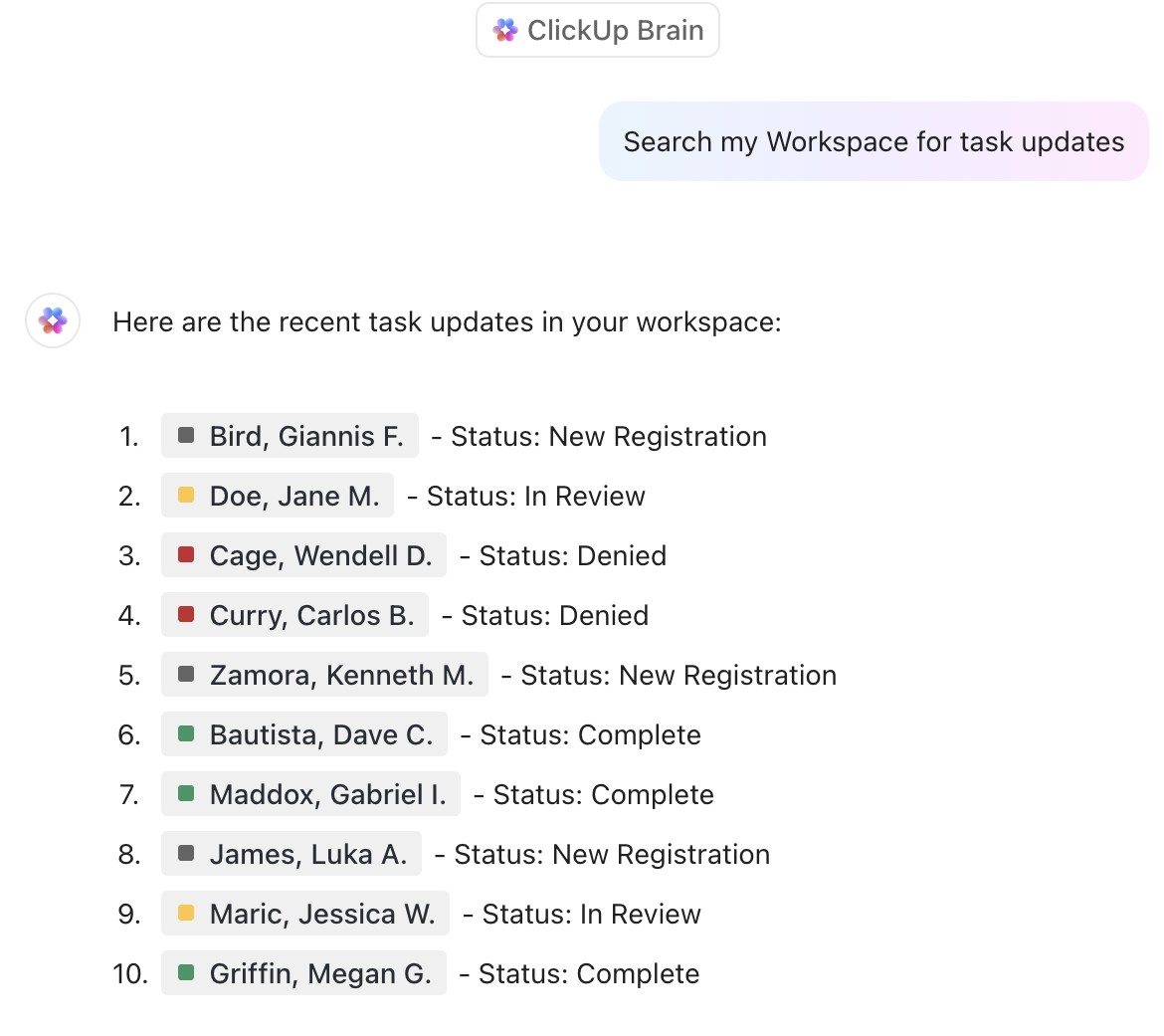
لا يعمل العمل غير المتزامن إلا عندما تجعل أدواتك من السهل الوصول إلى المعلومات وتفسيرها والتصرف بناءً عليها، دون الحاجة إلى ردود في الوقت الفعلي. وهذا بالضبط ما يفعله وكلاء الطيار الآلي في ClickUp.
🎯 على سبيل المثال، يمكن لوكيل الإجابات التلقائية المُعد مسبقًا الرد على الأسئلة باللغة الطبيعية مثل "ما هو وضع إطلاق الحملة التسويقية؟" أو "أين يمكنني العثور على قائمة مراجعة التهيئة؟" باستخدام البيانات في الوقت الفعلي من مساحة العمل الخاصة بك. وهذا يعني أن الأشخاص لا يضطرون إلى الانتظار لساعات حتى يرد عليهم شخص في منطقة زمنية أخرى، بل يمكنهم الحصول على الإجابات بأنفسهم في أي وقت.

💡 نصيحة احترافية: يمكن تدريب وكلاء الطيار الآلي المخصصين في ClickUp على التعامل مع سير عمل غير متزامن محدد. على سبيل المثال، يمكنك إنشاء وكيل اتصالات عملاء يراقب مجلدات المشروع ويقدم ملخصات محدثة لأصحاب المصلحة الخارجيين.
أنت تحدد الغرض من الوكيل ونبرته ومصادر البيانات، بحيث يمكنه العمل كزميل غير متزامن يعمل على مدار الساعة.

قم بتفويض المهام الروتينية المتكررة إلى ClickUp Automations
يمكنك أيضًا أتمتة سير عملك لتقليل العمل اليدوي وتجنب إرهاق الرسائل. تتيح أتمتة ClickUp للفرق إعداد مشغلات قائمة على القواعد بحيث يتم تنفيذ المهام تلقائيًا، مما يؤدي إلى تقدم العمل وإخطار أصحاب المصلحة دون الحاجة إلى تبادل الرسائل باستمرار.
📌 على سبيل المثال، بدلاً من القيام بدور الحكم بين كاتب النصوص والمصمم، يمكنك إنشاء أتمتة مخصصة تقوم تلقائيًا بتعيين مهمة حملة وسائل التواصل الاجتماعي إلى المصمم بمجرد اكتمالها ووضع علامة "جاهز للتصميم" عليها.
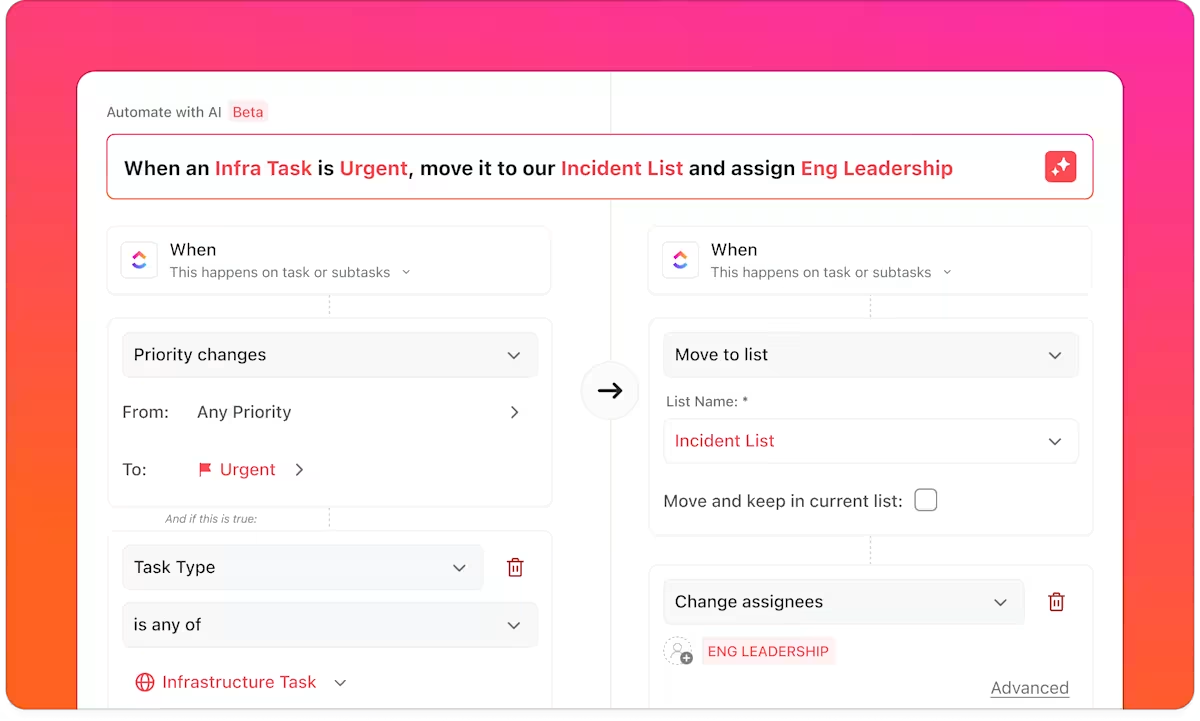
تحافظ هذه القواعد القائمة على المحفزات على إطلاع الجميع على جميع أنشطة ClickUp، حتى لو لم يكن الأشخاص متصلين بالإنترنت في نفس الوقت.
الخطوة 3: تحديد معايير وقت الاستجابة
ستفقد الاتصالات غير المتزامنة فعاليتها بمجرد أن يبدأ أعضاء فريقك في الاستخفاف بها. لذلك، حدد نوافذ استجابة واضحة بناءً على مدى الاستعجال والدور.
👉🏼 على سبيل المثال:
→ قدم ملاحظاتك على المخرجات في غضون 24 ساعة
→ إدارة مراجعات تحديثات المشروع في غضون يوم عمل واحد
→ قم بإجراء اتصالات غير رسمية كل يومين/ثلاثة أيام
📌 قم بتوثيق ذلك في دليل فريقك أو في موقع الويكي الداخلي حتى يكون الجميع على نفس الصفحة. أو استخدم نموذج الاجتماع اليومي.
على سبيل المثال، يساعد نموذج خطة الاتصال من ClickUp الفرق البعيدة على إعداد عمليات اتصال واضحة ومنظمة والحفاظ عليها بسرعة. وهو مثالي لتحديد التوقعات حول أوقات الاستجابة وتنظيم أهداف التعاون وتخطيط قنوات الاتصال.
إن تدوين هذه المعايير وإبرازها يساعد الموظفين الهجينين والعاملين عن بُعد على التواصل في بيئة يكون فيها الاتصال غير المتزامن هو الطريقة الافتراضية لإنجاز المهام.
باستخدام هذا النموذج، يمكنك:
- نظم أهداف التواصل والجداول الزمنية وأصحاب المصلحة والنتائج المرجوة في مكان واحد
- قم بتعيين حالات مخصصة وحقول مخصصة في ClickUp لتتبع كل جزء من استراتيجية الاتصال الخاصة بك.
- حدد طرق التواصل لمختلف أنواع العمل غير المتزامن (على سبيل المثال، التعليقات، تحديثات التعاون في المشاريع ، عمليات التحقق العرضية).
- قم بتعيين المسؤوليات وأتمتة التذكيرات حتى لا يترك أحد في حالة انتظار.
- قم بقياس النجاح من خلال تحديد المراحل الرئيسية وتتبع تقدم المهام عبر الفريق
📖 اقرأ أيضًا: كيفية إنشاء خطة اتصال للمشروع (أمثلة ونماذج)
الخطوة 4: شجع التوثيق بدلاً من المحادثة
قم بتغيير طريقة التفكير من "لنتصل" إلى "دعني أوثق هذا".
قد يبدو الأمر كما يلي:
- استبدال التحديثات الشفوية بملاحظات منظمة عن المشروع أو مقاطع فيديو تلخيصية
- تشجيع عادة تلخيص الخطوات أو القرارات التالية كتابةً مباشرة بعد المناقشات
يمكنك استخدام نموذج استراتيجية الاتصال الداخلي وخطة العمل من ClickUp لتسهيل هذا التحول من المحادثة إلى التوثيق. بدلاً من الاعتماد على المحادثات العشوائية والمكالمات المنسية، يساعدك هذا النموذج في إنشاء خطة منظمة وحيوية للاتصال الداخلي.
إليك كيفية استخدام هذا النموذج:
- قم بتقييم أساليب الاتصال الحالية لديك لتحديد الثغرات والعقبات.
- حدد أهدافًا واضحة لما يجب أن تحققه اتصالاتك الداخلية (تلميح: تقليل عدد الاجتماعات هو أحد هذه الأهداف)
- أنشئ قنوات رسمية (البريد الإلكتروني، الدردشة الداخلية، رسائل الفيديو السريعة) وقم بتثبيتها.
- قم بوضع خطوات قابلة للتنفيذ عن طريق تقسيم الخطة إلى مهام قابلة للتخصيص والتتبع.
💡 نصيحة احترافية: يمكنك أيضًا استخدام ClickUp AI Notetaker لتدوين المناقشات وتسجيل الأفكار المهمة التي يتم طرحها خلال الاجتماعات. يقوم هذا البرنامج بتسجيل اجتماعاتك وتلخيص النقاط الرئيسية، مما يوفر الوقت ويجعل السياق أكثر سهولة للجميع.
في الواقع، تتيح لك اجتماعات ClickUp تتبع وتعيين بنود العمل مباشرةً ضمن ملاحظات الاجتماع هذه.
على سبيل المثال، إذا قدم أحد أعضاء الفريق تحديثًا جديدًا لمشروع ما وظهرت مهمة متابعة، يمكنك استخدام التعليقات المخصصة في ClickUp وتفويض المهمة إلى الشخص المعني مباشرةً ضمن وثائق الاجتماع.

بمعنى آخر، بدلاً من إرسال رسالة إلى شخص ما "مرحبًا، هل رأيت هذا؟" خمس مرات في أماكن مختلفة، ما عليك سوى ترك تعليق واضح على المهمة أو المستند، وتعيينه له. إنه مثل دفعة خفيفة، مع مسؤولية مدمجة. يمكنهم التقاطها عندما يكونون جاهزين.
الخطوة 5: القيادة بالقدوة
الثقافة تتدفق من الأعلى إلى الأسفل. إذا استمر القادة في الاعتماد على الاجتماعات المباشرة أو توقعوا ردودًا فورية، فلن يتجذر الاتصال غير المتزامن أبدًا.
يجب عليهم أن يمارسوا ما ينصحون به - استخدام أدوات غير متزامنة، وتجنب إرسال رسائل بعد ساعات العمل، وتسجيل تحديثات فيديو قابلة للمشاركة بدلاً من جدولة مكالمات جماعية. هذا يحدد النغمة ويزيل شعور الموظفين بالذنب لعدم الاستجابة على الفور.
إذا كنت صاحب عمل وترغب في تسهيل اتباع الآخرين لقيادتك، فراجع ClickUp Clips. سيساعدك ذلك على دمج السلوك غير المتزامن في سير عملك اليومي.
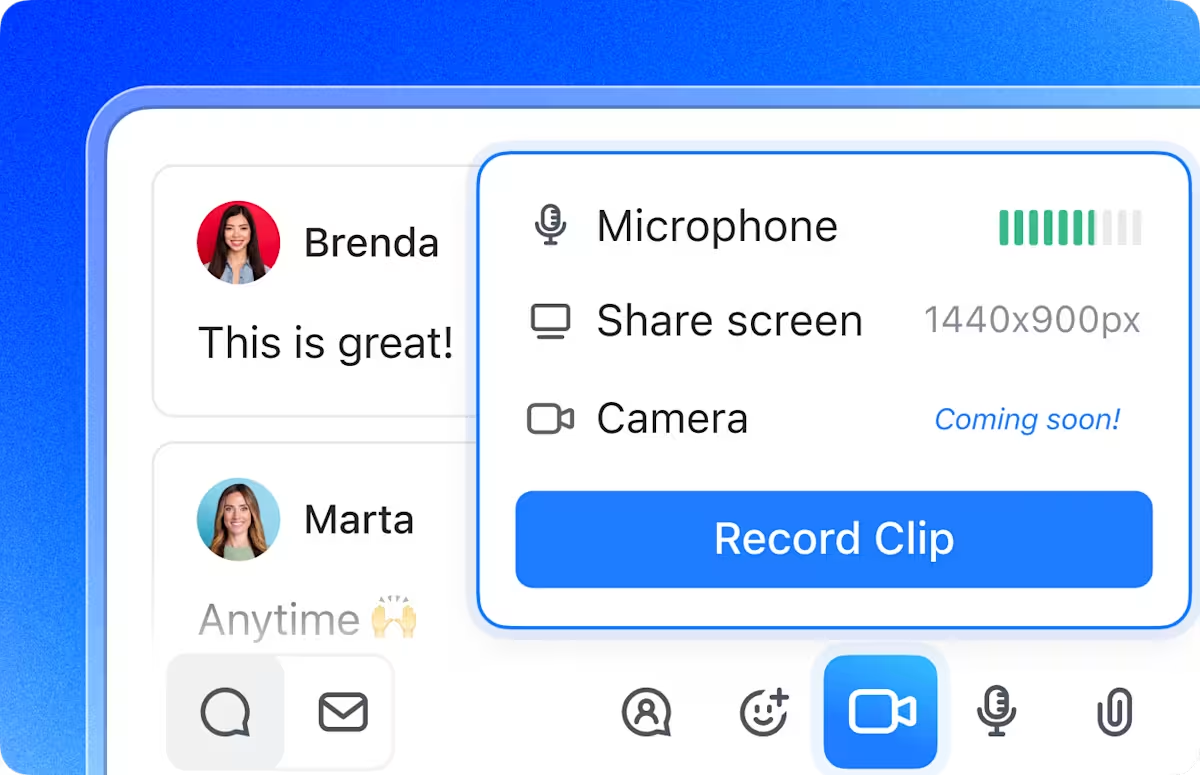
بدلاً من إجبار فريقك على حضور اجتماع "سريع" آخر يستغرق 45 دقيقة، يمكنك ببساطة تسجيل مقطع فيديو قصير — تسجيل شاشة قصير تستعرض فيه آخر مستجدات المشروع، أو تقدم ملاحظات، أو تشرح عملية معقدة.
يمكن للأشخاص مشاهدة رسالة الاتصال غير المتزامنة هذه دون تعارض في الجدول الزمني أو مشاكل في المنطقة الزمنية، وإعادة تشغيلها إذا لزم الأمر، وفهم المعلومات بشكل أفضل. إنها تمثل نمطًا أكثر صحة وتظهر أنك جاد في احترام وقت تركيز فريقك.
الخطوة 6: المراقبة والقياس والتعديل
بمجرد وضع الأنظمة غير المتزامنة موضع التنفيذ، قم بتقييم ما ينجح وما لا ينجح بانتظام.
اطرح الأسئلة التالية:
- هل يتم الالتزام بالمواعيد النهائية؟
- هل هناك أدوات معينة غير مستغلة بالشكل الكافي؟
- هل لا يزال بعض الأشخاص يشعرون بالارتباك تجاه مكالمات الفيديو؟
- هل تضيع المحادثات المهمة في سلاسل المحادثات الطويلة؟
اجمع التعليقات، وكرر مراجعة وثائقك، وراجع عملياتك كل ثلاثة أشهر. أو يمكنك مراقبة سير عملك باستخدام لوحات معلومات ClickUp وعرض حجم العمل.
تقوم لوحات معلومات ClickUp بتحويل بيانات مساحة العمل إلى مخططات ورسوم بيانية مرئية، مما يوفر نظرة عامة على تأثير فريقك. يمكنك بسرعة رؤية وقياس التقدم الشخصي والوقت المتتبع وأداء المشروع.
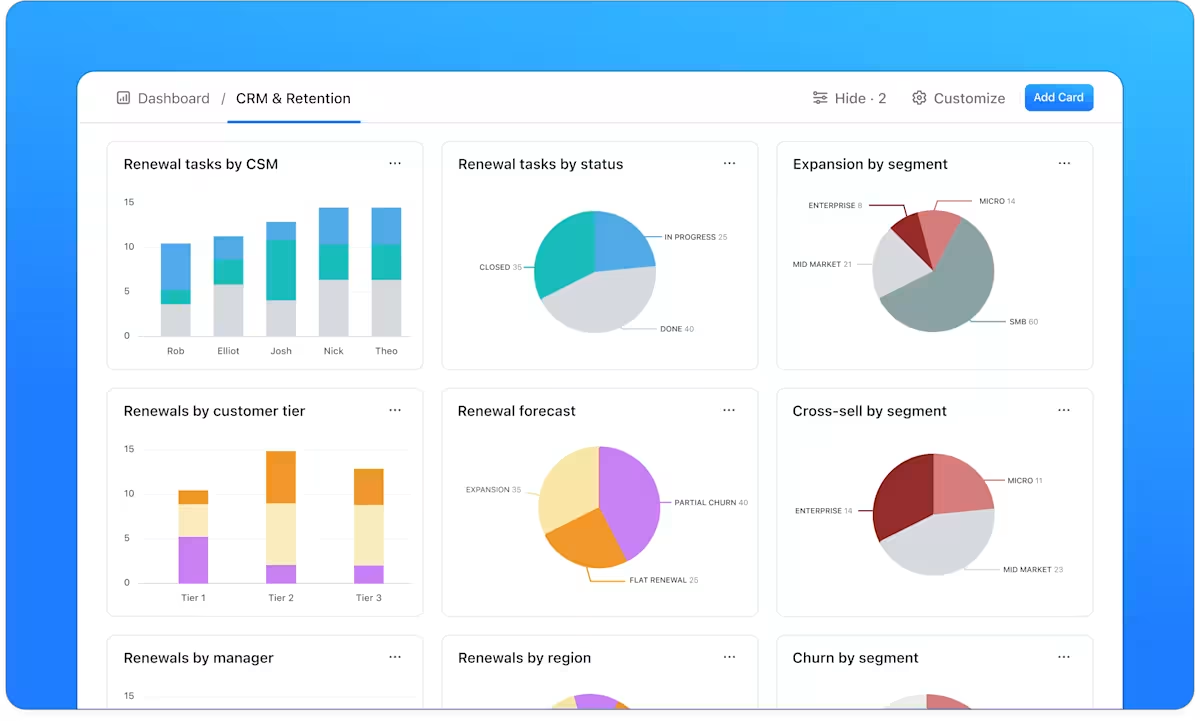
كما تتيح لك إنشاء تقارير مخصصة لكل شيء، مما يلغي الحاجة إلى التتبع اليدوي ويقلل من خطر ضياع المحادثات المهمة في سلاسل المحادثات الطويلة.
بينما تتعقب لوحات معلومات ClickUp أداء فريقك بشكل عام، تعرض ClickUp Workload View العمل المخصص لكل عضو في الفريق خلال فترة محددة.
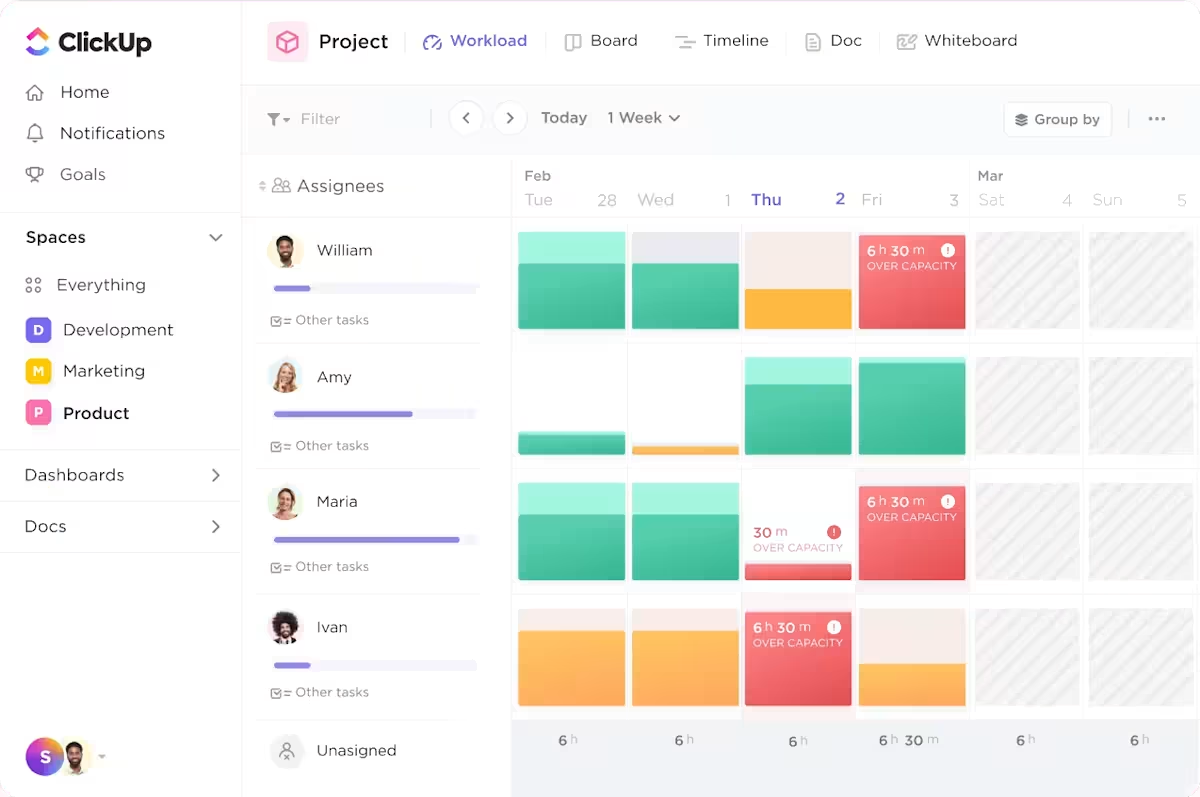
تحتوي مجموعة ClickUp Remote Work على ميزات إضافية تساعدك على معرفة من يعاني من عبء العمل الزائد ومن لديه القدرة على العمل، مما يتيح لك إعادة توزيع المهام وفقًا لذلك.
📖 اقرأ أيضًا: ما هو الاجتماع غير المتزامن وكيف يتم عقده؟
فوائد التواصل غير المتزامن
👀 هل تعلم؟ 71٪ من المهنيين العاملين يعتقدون أنه من المهم وجود حدود في مكان العمل، ولكن غالبًا ما يجد العاملون عن بُعد صعوبة في الحفاظ عليها. اكتشفت ClickUp أن 30٪ من العاملين يجدون صعوبة ذهنية في الانفصال عن العمل، وأن 8٪ فقط يضعون حدودًا صارمة على الإشعارات ورسائل العمل.
إليك ما ستكسبه عندما تتبنى عقلية الاتصال غير المتزامن بالكامل:
- امنح الفرق مزيدًا من المرونة لإدارة جداولهم الزمنية وذروة طاقتهم
- تجنب عقد اجتماعات متعددة عن طريق نقل التحديثات والأسئلة والتعليقات إلى اتصالات مكتوبة أو تنسيقات مسجلة.
- شجع التفكير العميق من خلال توفير المزيد من الوقت للتفكير في الردود المدروسة بدلاً من ردود الفعل التلقائية.
- حسّن التوثيق بشكل طبيعي مع تحول التواصل الشفهي إلى تحديثات مكتوبة
- قلل من التوتر وحسّن الصحة العقلية من خلال التخلص من توقعات الرسائل الفورية أو التوافر على مدار الساعة طوال أيام الأسبوع.
📮 ClickUp Insight: 48٪ من الموظفين يقولون إن العمل المختلط هو الأفضل لتحقيق التوازن بين العمل والحياة. ومع ذلك، مع استمرار 50٪ من الموظفين في العمل في المكتب في الغالب، قد يكون الحفاظ على التنسيق بين المواقع تحديًا. لكن ClickUp مصمم لجميع أنواع الفرق: عن بُعد، ومختلطة، وغير متزامنة، وكل ما بين ذلك.
باستخدام ClickUp Chat & Assigned Comments، يمكن للفرق مشاركة التحديثات بسرعة وتقديم الملاحظات وتحويل المناقشات إلى إجراءات دون الحاجة إلى اجتماعات لا نهاية لها. تعاون في الوقت الفعلي عبر ClickUp Docs و ClickUp Whiteboards، وقم بتعيين المهام مباشرة من التعليقات، وحافظ على تواصل الجميع بغض النظر عن مكان عملهم!
💫 نتائج حقيقية: شهدت STANLEY Security زيادة بنسبة 80٪ في رضا الفريق عن العمل الجماعي بفضل أدوات التعاون السلس من ClickUp.
تحديات التواصل غير المتزامن
👀 هل تعلم؟ بينما يعمل 38% من الموظفين في شركات تتبع سياسة عدم التزامن أولاً، فإن 34% منهم غير متأكدين مما إذا كانوا يرغبون في ذلك.
يبدو التواصل غير المتزامن مريحًا. ولكن لا يوجد شيء بدون قيود. إليك ما يمكن أن يحدث من مشاكل:
- الردود المتأخرة: بدون توقعات محددة، قد يبدو الاتصال غير المتزامن وكأنه ثقب أسود (لهذا السبب يجب عليك وضع إرشادات لوقت الاستجابة).
- الإفراط في التواصل أو سوء الفهم: الإفراط في التفاصيل قد يربك، ونقصها قد يسبب الارتباك (تذكر أن تحقق التوازن الصحيح)
- تراكم الأدوات: يمكن أن يتسبب العمل غير المتزامن عبر منصات متعددة في حدوث تضارب وتشتت المعلومات (قم بتركيز كل شيء في مكان واحد باستخدام ClickUp)
- نقص التواصل البشري: يمكن أن يسبب التواصل غير المتزامن الشعور بالعزلة إذا لم يقترن بمكالمات متزامنة من حين لآخر (لا تتخلى عن تلك اللقاءات المباشرة).
- مشكلات عدم التوافق: يمكن أن يؤدي الافتقار إلى التواصل في الوقت الفعلي إلى تشتت انتباه الأشخاص (احتفظ بأدوات رؤية المشروع ولوحات المعلومات والاتصالات المكتوبة في متناول اليد)
أفضل الممارسات للاتصال غير المتزامن
إذا تم تنفيذها بشكل صحيح، يمكن للاتصالات غير المتزامنة أن تلغي مكالمات الفيديو وتقلل من الاختناقات وتزيد من الإنتاجية دون إرهاق الموظفين.
اتبع هذه الممارسات الفضلى لتجعلها تستحق وقتك:
1. اجعل الرسائل قابلة للتنفيذ
الطلبات الواضحة مع تحديد مواعيد نهائية توفر الوقت وتمنع الالتباس.
اذكر بوضوح: ما الذي يحدث؟ ما الذي تحتاجه؟ متى؟
📌 مثال: "يرجى مراجعة الاقتراح المرفق وإرسال التعليقات بحلول يوم الجمعة، الساعة 3 مساءً."
2. قدم السياق الكامل مسبقًا
توفير السياق مسبقًا يقلل من التكرار ويحسن عملية اتخاذ القرار.
- أضف ملخصًا من 2 إلى 3 جمل قبل إدراج الروابط أو الملفات
- حدد المهمة والقرار المطلوب والمواعيد النهائية
📌 مثال: "تجديد العقد يحتاج إلى موافقة قانونية على الأقسام 4. 2 و 7. 1 بحلول نهاية يوم العمل الخميس."
3. إبراز النقاط الرئيسية
حافظ على الوضوح والإيجاز لتجنب الالتباس والتأخير.
- ابدأ بالخلاصة (TL;DR) إذا كان طول الرسالة أكثر من خمس أسطر.
- استخدم الرموز النقطية، وقم بتمييز المعلومات المهمة بالخط العريض، واربط الموارد مباشرةً
4. توثيق القرارات علنًا
احتفظ بسجل للقرارات لتجنب الالتباس وضمان المساءلة.
- سجل النتائج في الأدوات المشتركة (ClickUp، المستندات المشتركة، قوائم المهام)
- قم بتعيين الملكية على الفور
📌 مثال: "جون سيقدم المسودة بحلول 10 مايو"
5. تدريب الفرق على آداب العمل غير المتزامن
حتى لو كان 9 من كل 10 موظفين يعرفون كيفية استخدام أدوات التواصل غير المتزامن، فلن ينجح ذلك لأن أحد موظفيك سيستمر في المزج بين طرق التواصل المختلفة. لذا، اعمل على تحسين مهارات التعاون لدى فريقك.
💡 نصيحة احترافية: وفر الوقت وقم بتدريب موظفيك باستخدام ClickUp University. يتيح العمل ضمن نظام ClickUp لفريقك الوصول إلى أدلة إرشادية تفاعلية وإتقان الأدوات الأساسية للتعاون غير المتزامن.
أدوات لتسهيل التواصل غير المتزامن
الآن بعد أن تعرفت على كيفية التواصل غير المتزامن الفعال، إليك بعض الاقتراحات الإضافية للأدوات التي تجعل الحياة والمحادثات أسهل — إذا كنت تفضل عدم تجميعها جميعًا في ClickUp، بالطبع! 🤷🏻♀️🤷🏼♂️
1. Loom

Loom هي أداة مراسلة بالفيديو لتسجيل ومشاركة رسائل الفيديو، مما يجعلها مثالية للاتصال غير المتزامن. يمكنك نقل المعلومات بوضوح دون الحاجة إلى اجتماعات في الوقت الفعلي وتحسين العمل الجماعي عن بُعد.
2. Slack
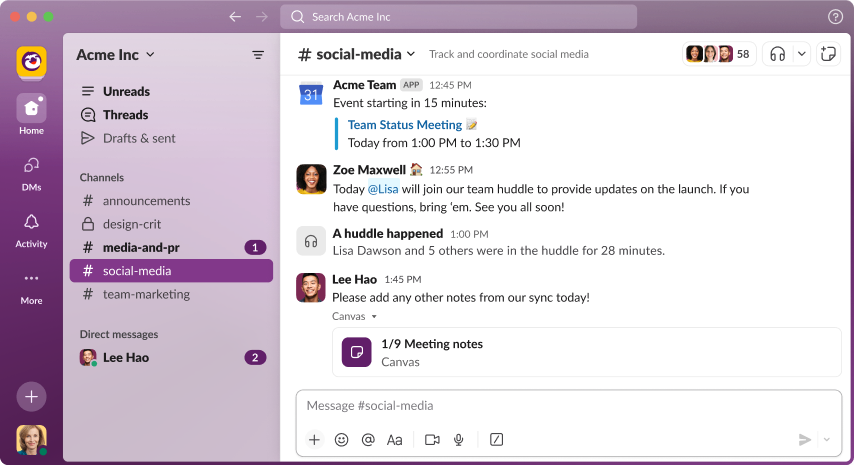
تنظم قنوات Slack المحادثات حسب الموضوع أو المشروع أو الفريق. يمكنك نشر التحديثات ومشاركة الملفات والتعاون دون الحاجة إلى ردود فورية، مما يقلل من اعتمادك على مؤتمرات الفيديو.
3. Microsoft Teams
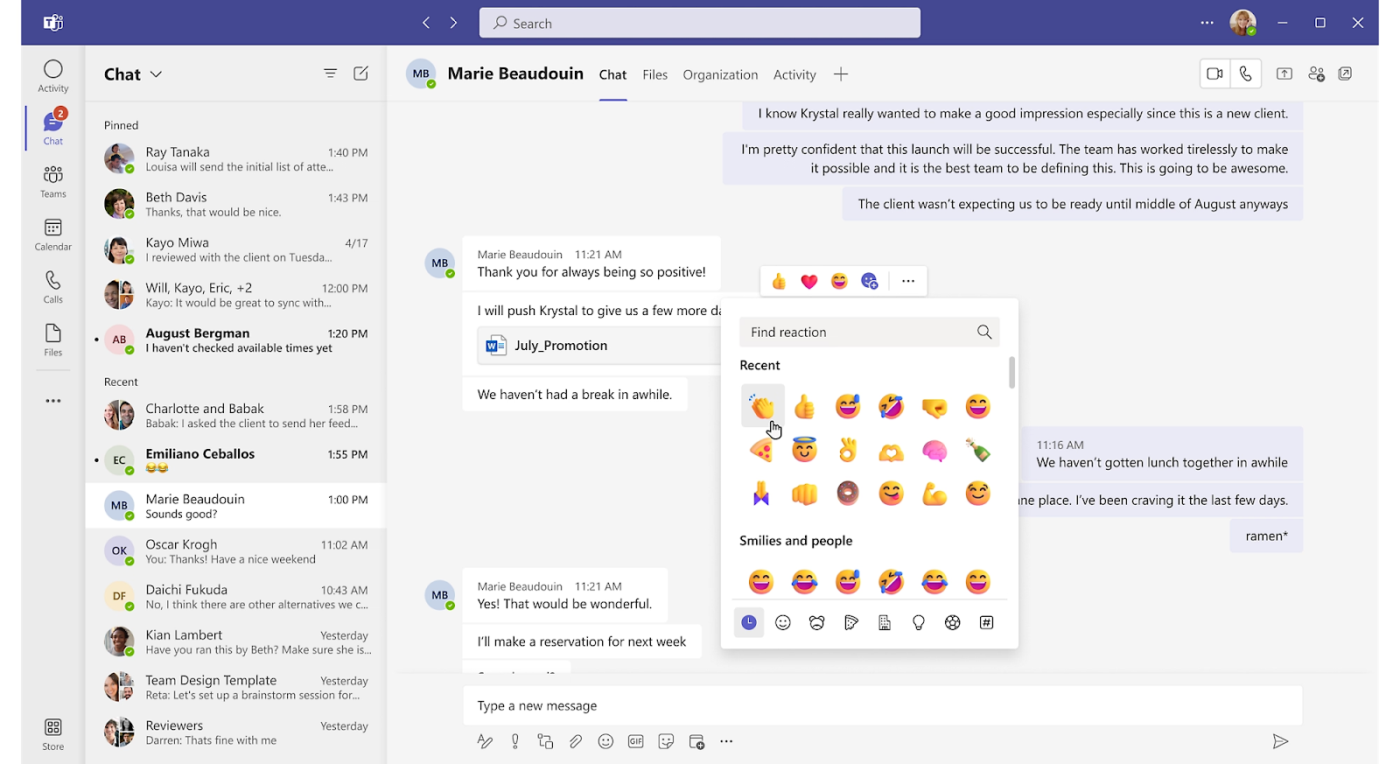
يضم Microsoft Teams الدردشة والاجتماعات عبر الفيديو وتخزين الملفات. وهو يدعم المراسلة غير المتزامنة من خلال المحادثات المترابطة والمستندات المشتركة وأدوات التعاون، مما يتيح لك العمل مع أعضاء الفريق عبر مناطق زمنية مختلفة.
📮ClickUp Insight: الفرق ذات الأداء المنخفض أكثر عرضة بأربع مرات لاستخدام أكثر من 15 أداة ، بينما تحافظ الفرق ذات الأداء العالي على كفاءتها من خلال قصر مجموعة أدواتها على 9 منصات أو أقل. ولكن ماذا عن استخدام منصة واحدة؟
باعتباره التطبيق الشامل للعمل، يجمع ClickUp مهامك ومشاريعك ووثائقك ومواقع الويكي والدردشة والمكالمات في منصة واحدة، مع سير عمل مدعوم بالذكاء الاصطناعي. هل أنت مستعد للعمل بشكل أكثر ذكاءً؟ يعمل ClickUp مع كل فريق، ويجعل العمل مرئيًا، ويسمح لك بالتركيز على ما يهم بينما يتولى الذكاء الاصطناعي الباقي.
متى تستخدم الاتصال غير المتزامن مقابل الاتصال المتزامن
لنتعلم كيفية الاختيار بين التواصل المتزامن وغير المتزامن بناءً على متطلبات الموقف.
استخدم الاتصال غير المتزامن في الحالات التالية:
1. تريد ردودًا مدروسة ومفصلة
أنت تعمل على اقتراح مشروع يحتاج إلى مدخلات من فرق موزعة.
بدلاً من جدولة اجتماع، انشر مستند ClickUp يوضح المسودة وقم بتعيين تعليقات لكل مراجع. يمكنهم أخذ وقتهم وإضافة ردود مدروسة جيدًا.

2. أنت تتعامل مع مناطق زمنية مختلفة
مدير التسويق لديك في نيويورك، لكن مصممك في برلين. مكالمة Zoom في الساعة 6 صباحًا/10 مساءً تبدو ككابوس، أليس كذلك؟
لذا، قم بتسجيل رسالة فيديو باستخدام ClickUp Clips تشرح تحديثات التصميم وقم بتمييز المصمم مع عناصر العمل داخل نفس المنصة. يتيح التعاون متعدد الوظائف لهم الرد خلال يوم عملهم، مما يوفر عليك عقد اجتماع آخر.
3. التحديث ليس عاجلاً أو عاطفياً
لقد انتهيت من مرحلة سريعة وتحتاج إلى مشاركة تحديث الحالة، ولكنك لا تحتاج إلى ردود فورية.
في هذه الحالة، انشر تحديثًا للمشروع في ClickUp Chat وقم بتمييز الأطراف المعنية الرئيسية أو أعضاء الفريق المعنيين.
4. تريد مسارًا قابلًا للبحث وموثقًا
أنت بصدد الانتهاء من إجراءات التوظيف لأعضاء الفريق الجدد. سجل مقطع فيديو ClickUp يشرح الخطوات واربطه في مستند عملية ClickUp الخاص بك.
لا يقتصر الأمر على توحيد عملية التعيين فحسب، بل يساعدك أيضًا على توفير دليل للموظفين الجدد يمكنهم الرجوع إليه في أي وقت.
استخدم الاتصال المتزامن في الحالات التالية:
1. تحتاج إلى اتخاذ قرار سريع أو عقد جلسة عصف ذهني
أنت تحاول الاستقرار على اسم لمنتج ما.
قد يستغرق سلسلة تعليقات ClickUp أيامًا من "ماذا عن هذا؟" و"ربما" و"أو هذا". سيكون من الأسرع ترتيب مكالمة فيديو سريعة.
أفضل ما في الأمر هو أن تكاملات ClickUp تتصل بسلاسة مع Zoom و Microsoft Teams. يمكنك جدولة الاجتماعات مباشرة من تقويم ClickUp الخاص بك دون مغادرة المنصة.
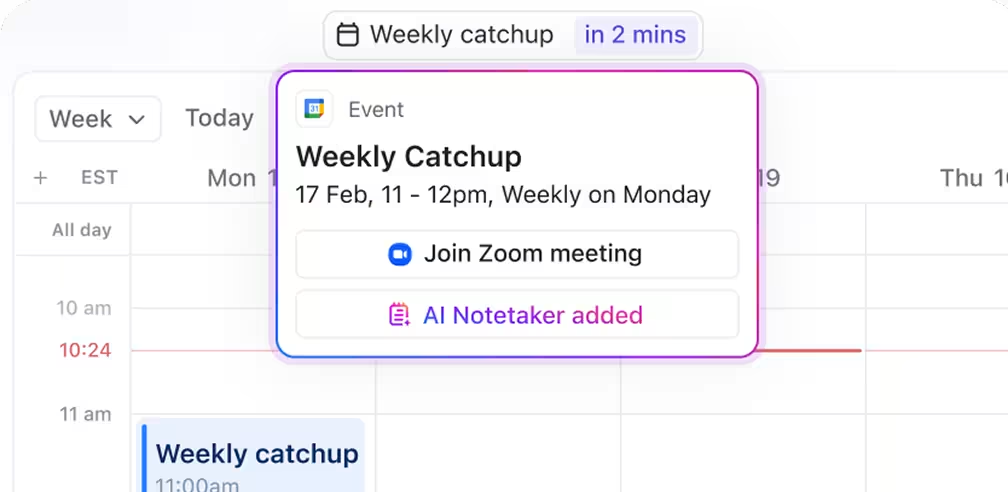
2. أنت تتناول موضوعات حساسة أو عاطفية
تحتاج إلى تقديم ملاحظات فورية حول المواعيد النهائية التي لم يتم الالتزام بها مع مراعاة حساسية مسألة معينة.
في هذه الحالة، تتيح لك مكالمة الفيديو الفردية إظهار التعاطف وقراءة لغة الجسد وتجنب سوء الفهم الذي قد يحدث في الرسائل النصية.
3. أنت تعمل على حل مشكلة معقدة
هناك خطأ غريب في التطبيق لا يمكن لأحد تكراره. بدلاً من إرسال عشرات الرسائل النصية، يمكن حل المشكلة بشكل أسرع من خلال مكالمة هاتفية مع المطورين ومشاركة الشاشة عبر مؤتمر فيديو لمشاهدة المشكلة مباشرة.
💡 نصيحة احترافية: قم بإجراء مكالمة صوتية أو مرئية سريعة مباشرة من داخل ClickUp Chat. تتيح لك ميزة SyncUps من ClickUp التواصل مع زملائك وعملائك وحل المشكلات المعقدة بشكل أسرع من خلال ميزة مشاركة الشاشة المدمجة.
4. أنت تبني الثقة والعلاقات
هل تحتاج إلى جعل أعضاء الفريق الجدد يشعرون بالراحة؟ تعد المحادثات وجهًا لوجه، إلى جانب بعض الأنشطة لكسر الجليد، أدوات رائعة لبناء الفريق. فهي تبني علاقات ترابطية قد يستغرق التواصل غير المتزامن شهورًا لتطويرها.
من يستفيد أكثر من التواصل غير المتزامن؟
يعمل العمل غير المتزامن على تعزيز العمل بشكل فعال لبعض الأشخاص والفرق. إليك من سيحقق أكبر المكاسب:
| أنواع الأشخاص/الفرق | كيف تساعدهم الاتصالات غير المتزامنة |
| الفرق البعيدة والموزعة | اعمل عبر المناطق الزمنية دون تأخير أو سهر طوال الليل |
| المهنيون الذين يقضون الكثير من الوقت في العمل المكثف | حافظ على ساعات طويلة من التركيز دون انقطاع للحصول على نتائج عالية الجودة |
| الشركات العالمية | تمكين التعاون السلس دون الحاجة إلى تداخل ساعات العمل |
| الانطوائيون والمفكرون المتأملون | امنح الوقت الكافي لمعالجة وصياغة ردود مدروسة ومنظمة جيدًا. |
| المنظمات التي تعطي الأولوية للتوازن بين العمل والحياة | احترم الوقت الشخصي، وقلل من الإرهاق، وادعم حدود عمل أكثر صحة. |
📖 اقرأ أيضًا: كيفية العمل من المنزل: نصائح وأفضل الممارسات
ابق على اتصال، حتى في حالة عدم التزامن — فقط مع ClickUp
تشجع الاتصالات غير المتزامنة على التركيز، وتحسن الإنتاجية، وتقلل من الحاجة إلى الاجتماعات غير الضرورية. وتساهم هذه العوامل مجتمعة في تحسين رفاهية الموظفين.
ولكن لكي تكون الاتصالات غير المتزامنة فعالة حقًا، لا تحتاج إلى النوايا الحسنة فحسب، بل تحتاج أيضًا إلى النظام المناسب.
ClickUp ليس مجرد أداة اتصال أخرى. إنه مركز العمل غير المتزامن الشامل الخاص بك، حيث تجتمع المهام والمستندات والتعليقات والدردشة والوكلاء المدعومون بالذكاء الاصطناعي للحفاظ على تماسك الجميع وإبقائهم على اطلاع ومواصلة التقدم، بغض النظر عن وقت أو مكان عملهم.
لذلك، فإن ClickUp وميزاته مناسبة تمامًا. يتجاوز هذا البرنامج التعامل مع الاتصالات. فهو يفهم سير عملك ويصبح الحل المفضل لديك لكل إجراء متعلق بالعمل، بينما يوفر أيضًا العديد من أدوات الاتصال غير المتزامن.
لماذا تتعامل مع خمسة أدوات مختلفة بينما يوفر لك ClickUp كل ذلك في أداة واحدة؟ جرب ClickUp مجانًا واكتشف كيف يعمل الاتصال غير المتزامن.

